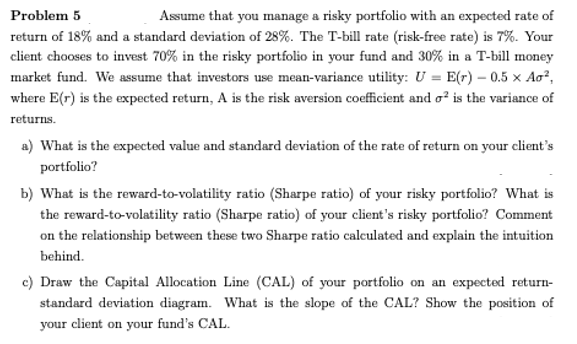Problem 5 Assume that you manage a risky portfolio with an expected rate of return of 18% and a standard deviation of 28%. The T-bill rate (risk-free rate) is 7%. Your client chooses to invest 70% in the risky portfolio in your fund and 30% in a T-bill money market fund. We assume that investors use mean-variance utility: U = E(r) – 0.5 × Ao², where E(r) is the expected return, A is the risk aversion coefficient and o² is the variance of returns. a) What is the expected value and standard deviation of the rate of return on your elient's portfolio? b) What is the reward-to-volatility ratio (Sharpe ratio) of your risky portfolio? What is the reward-to-volatility ratio (Sharpe ratio) of your client's risky portfolio? Comment on the relationship between these two Sharpe ratio calculated and explain the intuition behind. c) Draw the Capital Allocation Line (CAL) of your portfolio on an expected return- standard deviation diagram. What is the slope of the CAL? Show the position of
Problem 5 Assume that you manage a risky portfolio with an expected rate of return of 18% and a standard deviation of 28%. The T-bill rate (risk-free rate) is 7%. Your client chooses to invest 70% in the risky portfolio in your fund and 30% in a T-bill money market fund. We assume that investors use mean-variance utility: U = E(r) – 0.5 × Ao², where E(r) is the expected return, A is the risk aversion coefficient and o² is the variance of returns. a) What is the expected value and standard deviation of the rate of return on your elient's portfolio? b) What is the reward-to-volatility ratio (Sharpe ratio) of your risky portfolio? What is the reward-to-volatility ratio (Sharpe ratio) of your client's risky portfolio? Comment on the relationship between these two Sharpe ratio calculated and explain the intuition behind. c) Draw the Capital Allocation Line (CAL) of your portfolio on an expected return- standard deviation diagram. What is the slope of the CAL? Show the position of
Chapter8: Risk And Rates Of Return
Section: Chapter Questions
Problem 9PROB
Related questions
Question
100%

Transcribed Image Text:Problem 5
Assume that you manage a risky portfolio with an expected rate of
return of 18% and a standard deviation of 28%. The T-bill rate (risk-free rate) is 7%. Your
client chooses to invest 70% in the risky portfolio in your fund and 30% in a T-bill money
market fund. We assume that investors use mean-variance utility: U = E(r) – 0.5 x Aa?,
where E(r) is the expected return, A is the risk aversion coefficient and o? is the variance of
returns.
a) What is the expected value and standard deviation of the rate of return on your client's
portfolio?
b) What is the reward-to-volatility ratio (Sharpe ratio) of your risky portfolio? What is
the reward-to-volatility ratio (Sharpe ratio) of your client's risky portfolio? Comment
on the relationship between these two Sharpe ratio calculated and explain the intuition
behind.
c) Draw the Capital Allocation Line (CAL) of your portfolio on an expected return-
standard deviation diagram. What is the slope of the CAL? Show the position of
your client on your fund's CAL.
Expert Solution
This question has been solved!
Explore an expertly crafted, step-by-step solution for a thorough understanding of key concepts.
Step by step
Solved in 4 steps with 1 images

Knowledge Booster
Learn more about
Need a deep-dive on the concept behind this application? Look no further. Learn more about this topic, finance and related others by exploring similar questions and additional content below.Recommended textbooks for you


EBK CONTEMPORARY FINANCIAL MANAGEMENT
Finance
ISBN:
9781337514835
Author:
MOYER
Publisher:
CENGAGE LEARNING - CONSIGNMENT

Intermediate Financial Management (MindTap Course…
Finance
ISBN:
9781337395083
Author:
Eugene F. Brigham, Phillip R. Daves
Publisher:
Cengage Learning


EBK CONTEMPORARY FINANCIAL MANAGEMENT
Finance
ISBN:
9781337514835
Author:
MOYER
Publisher:
CENGAGE LEARNING - CONSIGNMENT

Intermediate Financial Management (MindTap Course…
Finance
ISBN:
9781337395083
Author:
Eugene F. Brigham, Phillip R. Daves
Publisher:
Cengage Learning